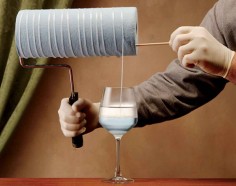Nick Relph
Tomorrow there is no Recording

source: e-flux
New York-based artist Nick Relph, who works across video, drawing and installation.
Tomorrow There Is No Recording examines handicraft, materials and ideas of value and exchange, and the relationship of industrial processes to contemporary economic models. Using a four-harness floor loom, Relph has fabricated a series of small weaves using materials including polyester, rayon, silk, monofilament, latex and paper. The weaves are presented at Chisenhale as part of a specially conceived installation.
Relph’s interest in handmade, woven textiles stems from an appreciation of the labour involved in their production, in addition to the particular formal and material resonance of these constructed fabrics within our digitally oriented culture. Woven surfaces can be read as images, whilst also retaining the information of their making—mistakes and irregularities or impressions from the loom—and the signs of wear that emerge over time and through use. This preoccupation with the relationship between image and surface emerges from Relph’s previous film and video work. He has said: ‘I can’t think about moving image now without thinking about the surface upon which it’s being viewed.’
Relph first began to explore his interest in the material and social effects of textiles through moving image. Thre Stryppis Quhite Upon ane Blak Field (2010)—presented at the Venice Biennial in 2011 and currently on display at Tate St Ives—connects the meandering history of tartan with the Japanese fashion label Comme des Garçons and the artist Ellsworth Kelly. Here, Relph employs a trilogy of colour—red, blue and green—as a visual motif and conceptual device to weave associations between subject matter in the film. The history of colour reproduction, manufacture and consumption are further explored through the presentation of the film as a composite RGB projection, which recalls the mechanical print processes used in the textile industry.
Relph’s contemporary methodology of accumulating, cutting and pasting, and manipulating research material, as a source of both information and inspiration, is juxtaposed with materials and processes that are idiosyncratic and often homespun. The links Relph makes are tentative, suggesting something elliptical at play in the manufacture and circulation of goods, and, in turn, influencing our subjective attachment to them.
Nick Relph (b. 1979, London) lives and works in New York. Recent solo exhibitions include Gavin Brown’s Enterprise, New York (2012); Standard, Oslo (2011); Herald Street, London (2010) and Frieze Projects, Frieze Art Fair (2010). Recent group exhibitions include Summer 2013, Tate St Ives (2013), How To Look At Everything, Common Guild, Glasgow (2012); Modify as Needed, Museum of Contemporary Art, Miami (2011). Relph was a participating artist in ILLUMInations, the 54th Venice Biennale (2011).
.
.
.
.
.
.
.
source: timeout
You can picture Nick Relph sat at a loom for hours on end, weaving together endless strands of silk and cotton like some medieval artisan. It’s a quizzical image – the young, London-born artist recast as an old-fashioned craftsman. Despite his insistence that these new pieces are purely about finish and surface, Relph’s weavings and photographs pose questions about value and the distinctions between art and craft.
Depicting things such as a gnarled potted plant, spilt water and a ripped bus seat, the seven photographs seem barely composed. The fabrics pieces, on the other hand, are sumptuous. An elegant aesthetic collides with an almost primitive approach in works that echo the forms and colours of minimalist paintings. They’re intensely constructed and filled with knots which create undulating textures to catch the eye.
But what is Relph trying to say by hanging them next to casual photos? That each has the same worth? The contrast between beautiful and ugly feels forced, as if you’re not allowed to like Relph’s weavings just because they’re pretty.

